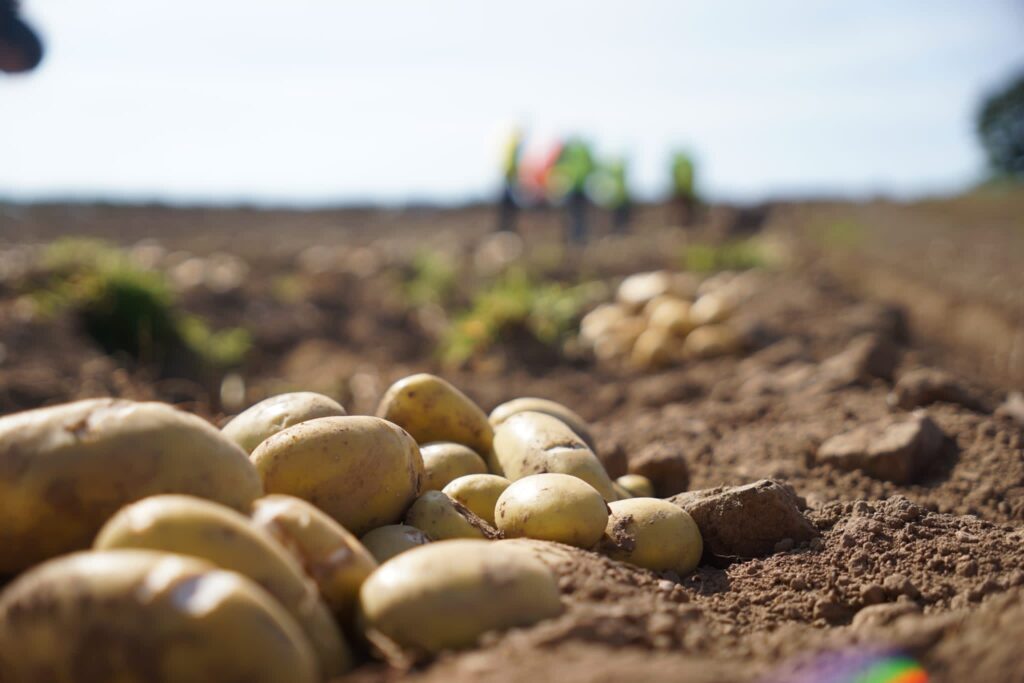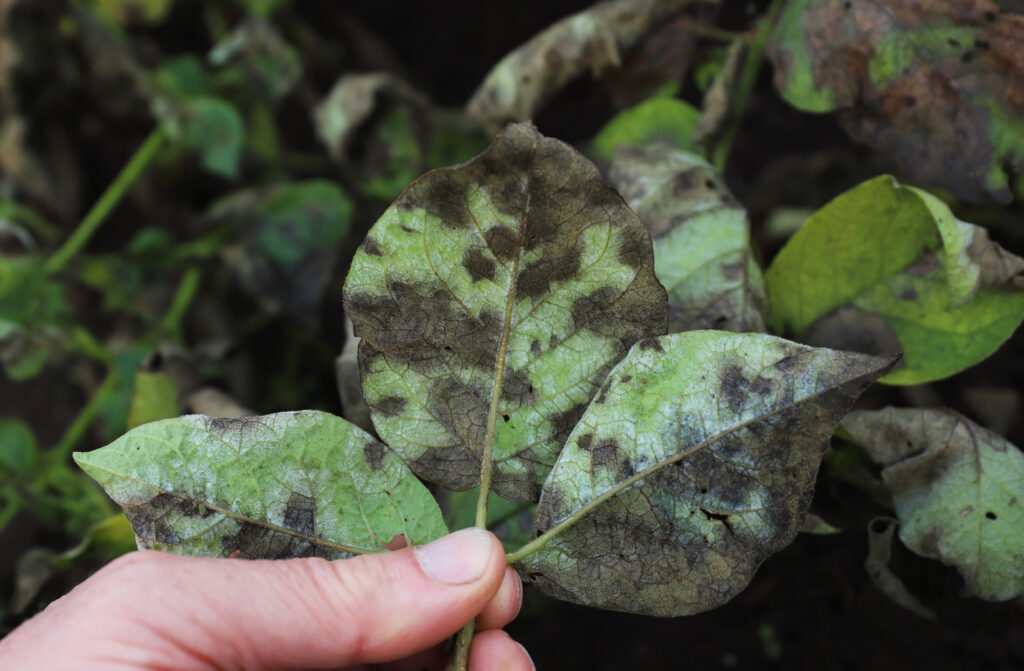The James Hutton Institute is at the centre of global efforts to help potato breeders and growers stay ahead of the constantly-evolving threat of new strains of the late blight pathogen that precipitated the Irish Potato Famine in the 1840s.
Late blight is caused by Phytophthora infestans, a rapidly-spreading type of plant pathogenic water mould that can infect both potatoes and tomatoes, swiftly killing the crops. It causes lesions on leaves and stems and as it progresses causes potatoes in the soil or in storage to rot.
Every few years a new dominant strain of the late blight pathogen emerges, causing major problems for farmers as existing solutions such as specific fungicides, may not be effective in tackling new strains that are likely to have different genetic traits.
A specialist team headed by David Cooke and Alison Lees, Research Leaders in Cell and Molecular Sciences, has made major scientific breakthroughs over the last two decades in developing and exploiting a molecular marker system that allows the rapid DNA fingerprinting of new strains of the late blight pathogen.
It is vital work as late blight is the single most serious threat to potato production, resulting in estimated annual global industry costs of more than £20 billion from a combination of crop losses and the cost of treating the disease. In the UK alone, the industry spends an estimated £50 million per season tackling late blight.
Did you know…
Late blight is the single most serious threat to potato production, resulting in estimated annual global industry costs of more than £20 billion from a combination of crop losses and the cost of treating the disease.


The institute is a global leader in potato research and responsible for the Commonwealth Potato Collection, a world-class resource covering more than 1,500 accessions of potato. The institute’s scientists share expert knowledge on different aspects of potato breeding and production, from late blight epidemiology to developing new varieties of disease-resistant potato, fungicide resistance, integrated pest management and sustainable farming practices.
The team has amassed a valuable long-term data set covering more than 2,700 late blight outbreaks and created 10,000 separate data points that create a highly detailed understanding of the nature and behaviour of diverse late blight strains.
Along with Peter Skelsey in Hutton’s Information and Computational Sciences group they use machine learning tools to model factors linked to the spread of late blight and cluster analysis which enables them to assess risk of outbreaks within the UK on a postcode district basis.
Over two decades, working in collaboration with other international institutions, including Aarhus University in Denmark, they have led the way in confirming the appearance of several new late blight clones affecting crops in major potato-growing countries.
“Defining the genotype of a clone is just the start. You also need to determine what its traits are, how rapidly it’s spreading, how aggressive it is, whether fungicides are effective, and whether it’s going to be a problem for the industry,” says Cooke.
“A tiny foliar late blight lesion of one square centimetre can produce 20,000 spores every day which spread disease when they become airborne. If you get management of the disease wrong, you can go from a healthy crop to total crop destruction very quickly.”
The Hutton team have been involved in early warning monitoring systems for late blight for years, both at a national and international level. They ran the UK’s ‘Fight Against Blight’ programme which began in 2004 and was until recently funded by the Agriculture and Horticulture Development Board (AHDB). The institute is currently seeking new sources of finance from the industry.
As part of this work, ‘blight scouts’ around the country send samples of potentially infected potato plants to the institute for genotyping. They use a globally accepted collection system which involves pressing samples onto special paper so that DNA can be extracted and analysed.
The team is also key to EuroBlight – a Pan-European late blight network involving several research institutions, the potato industry and the agrochemical sector. They also work with similar networks and conduct research work in Asia and South America.
Among recent major developments, a EuroBlight report on a new late blight strain that emerged in Denmark in 2018 documents resistance to one of the most important group of fungicides in potato production which is presenting new challenges for scientists and for farmers.
Fungicides are one way in which farmers can tackle late blight – other measures include crop rotation, good soil hygiene, using high quality seed potatoes and being careful to destroy plants that grow from waste, or unharvested, potato tubers.
Regular spraying with fungicides can protect crops. However, Cooke says risks have magnified and crop spraying strategies have become more complex as new late blight strains are increasingly resistant to certain fungicides. Farmers need accurate and timely information on fungicide-resistance to protect their crops.
The issue is further complicated by legislative efforts to reduce the use of fungicides in general in the farming sector. The European Commission, for example, has committed to a 50% reduction in the use and risk of chemical pesticides by 2030. The impetus is to encourage wider adoption of sustainable and climate-friendly farming practices.
Almost two centuries after The Irish Potato Famine, vigilant monitoring and collaborative research to combat constantly evolving strains of the late blight pathogen remains important.
A tiny foliar late blight lesion of one square centimetre can produce 20,000 spores every day which spread disease when they become airborne. If you get management of the disease wrong, you can go from a healthy crop to total crop destruction very quickly.
David Cooke, Research Leader in Cell and Molecular Sciences at the James Hutton Institute.
